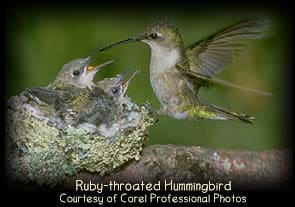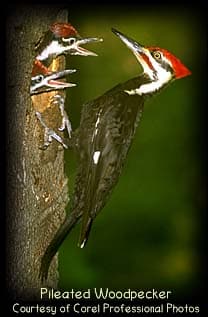Pines exist in every Eastern Forest, but the Pine Barrens and Pinelands are dominated by pine trees and therefore requires it’s own section in the Habitat of Birds.
Pine Barrens:
In the Eastern United States, the Pine Barrens are found in central and southern New Jersey and cover almost 1 1/2 million acres bounded on the east by the Atlantic Coast and on the west by deciduous forests. The term barrens indicates land covered with stunted forests and with poor soil. The Pine Barrens of New Jersey occur mostly on sand and are dominated by Pitch Pine. The Pine Barrens have wet lowlands and dry uplands. In the lowlands, swamp-like forests are dominated by Red Maple, Swamp Magnolia, Pitch Pine, shrubby plants and ground cover that grow in damp soils such as Bayberry and Chain Fern. In the drier uplands the barrens are dominated by Pitch Pine and some other pines such as the Shortleaf and Virgina Pines. Shrubs such as Black Huckleberry and Bear Oak form thickets under the pines. Common birds of the Pine Barrens include the Carolina Wren, Blue Jay, Carolina Chickadee, Eastern Towhee and Northern Mockingbird.
Southern Pinelands:
From the southern New Jersey Pine Barrens south to Florida and west to Texas, are the Southern Pinelands. These pinelands consist of pure groves of Loblolly Pine and Longleaf Pine mixed with Hickories and Oaks, Slash Pine and Sand Pine, Shortleaf Pine with Hickories and Oaks with swamps, bogs and bays. In the States of Georgia, Maryland, Virginia, Florida and westward to Texas, the Southern Pinelands differ due to differences in soil, drainage and precipitation. The Pinelands of Maryland and Virginia contains mixed deciduous forest and the Pitch Pine of the New Jersey Pine Barrens is replaced with Virginia Pine. The more south we go, the forests are dominated by Longleaf Pine and swamps are encountered. Pineland fires have benefited the Red-bellied Woodpecker in that they nest in dead trees while on the other hand the Red-cockaded Woodpecker nests in live Longleaf and Loblolly Pine.
| Birds | Breeding/Nest Facts |
| American Redstart | Breeds in mixed woodlands bordering water and shrubs. Nest in shrub or tree 5′-10′ from ground. |
| Black-and-white Warbler | Breeds in deciduous forests. Nest in hollow on ground against a shrub among roots. |
| Blue-gray Gnatcatcher | Breeds in most forests near water. Nest in tree or shrub anywhere from 3-75′ from ground. |
| Brown Creeper | Nest concealed behind loose bark or in crevice. 5-15′ from ground. |
| Carolina Chickadee | Breeds in woodlands or around buildings. Nest in cavity with decayed wood. |
| Chuck-will’s-widow | Breeds in Pine woods. Eggs are laid on leaves or pine needles under trees. |
| Downy Woodpecker | Breeds in woodlands, parks with trees. Nest in cavity in dead wood. |
| Hairy Woodpecker | Breeds in woodlands and edges or parks with trees. Nest in cavity in live tree. |
| Hooded Warbler | Breeds in moist deciduous forest. Nest in shrub anywhere from 1-4′ from ground in twig fork. |
| Northern Saw-whet Owl | Breeds in coniferous woodlands near swamps. Uses old woodpecker cavity for nest. |
| Northern Cardinal | Breeds in thickets, woodland edges. Nest in shrub anywhere from 4-6′ from ground. |
| Ovenbird | Nest on ground in small hollow with side entrance; concealed by vegetation. |
| Pine Warbler | Breeds in Pine Woods. Nest on horizontal branch of pine tree anywhere from 15-75′ above ground. |
| Prairie Warbler | Breeds in woodlands amoung low scrub or thickets. Nest in schrub about 1-10′ above ground. |
| Red Crossbill | Nest on edge of branch of pine and concealed by twigs and foliage. |
| Ruby-throated Hummingbird | Breeds in wooded habitats. Nest on tree or shrub anywhere from 10-20′ above ground. |
| Ruffed Grouse | Nest on ground at base of bushes or trees. |
| Tufted Titmouse | Breeds in coniferous or deciduous woodlands. Nest in cavity of tree or old woodpecker hole. |
| Whip-poor-will | Breeds in open deciduous forests. No nest is built, but eggs laid on ground under tree or under a shrub. |
| White-breasted Nuthatch | Breeds in deciduous forests. Nest in natural cavity of deciduous tree anywhere from ground level to 50′ up. |
| White-eyed Vireo | Breeds in woodland edges, thickets and shrub growth near water. Nest suspended anywhere from 3-10′ from ground. |
| White-throated Sparrow | Breeds in woodland edges near open areas. Nest on ground under shrubs or ferns. |
| Wild Turkey | Breeds in open deciduous forests along edges. Nest on ground by or under shrubs. |
| Wood Thrush | Breeds in moist deciduous forest near water. Nest in shrub or tree on small branch anywhere from 10-50′ from ground. |
| Yellow-breasted Chat | Breeds in thick shrubbery of forest edge. Nest located ground level to 4′ up in shrub. |
| Yellow-throated Vireo | Breeds in mixed forest clearings. Nest anywhere from 5-20′ from ground usually on a deciduous tree. |
| Birds | Breeding/Nest Facts |
| Acadian Flycatcher | Breeds in moist deciduous woodlands along ravines. Nest suspended on twig fork near end of branch. |
| American Robin | Breeds in woodlands, grasslands, yards, farmlands. Nest in tree or shrub anywhere from 3-20′ above ground. |
| Blue Jay | Breeds in mixed forests. Nest in tree anywhere from 10-45′ from ground. |
| Brown Thrasher | Breeds around woodland edges in overgrown shrubbery. Nest near ground low in shrub. |
| Brown-headed Nuthatch | Breeds in Pine woods. Nest in cavity of dead wood. |
| Eastern Towhee | Breeds in undergrowth of forest or near forest edge. Nest on ground concealed by dense bushes. |
| Gray Kingbird | Nest in tree anywhere from 3-12′ above ground. |
| Kentucky Warbler | Breeds in moist deciduous forest with heavy ground vegetation. Nest on ground at base of tree or shrub concealed by vegetation. |
| Mississippi Kite | Breeds in pine forests. Nest anywhere from 30-130′ above ground. |
| Northern Parula | Breeds in woodlands. Nest in coniferous or deciduous tree anywhere from 5-15′ above ground. |
| Painted Bunting | Breeds in growth of shrubs or hedgerows. |
| Red-bellied Woodpecker | Breeds in variety of woodland habitats.Nest in cavity of tree trunk or stump. |
| Red-cockaded Woodpecker | Breeds in Southern Pinelands. Nest cavity in tree trunk anywhere from 18-50′ above ground. |
| Red-shouldered Hawk | Breeds in moist woodlands. Nest on large tree. |
| Summer Tanager | Breeds in Pine/Oak Woodlands. Nest on horizontal low branch anywhere from 10-35′ above ground. |
| Swallow-tailed Kite | Breeds in wooded areas by water. Nest near woodland edge 60-100′ above ground on tree. |
| Wood Stork | Breeds in water where trees grow. Nest usually on treetops. |
| Yellow-throated Warbler | Breeds in pine woodlands near water. Nest on horizontal branch anywhere from 15-55′ above ground. |


